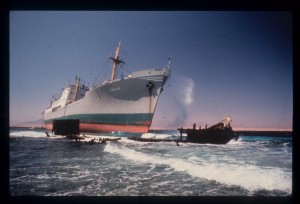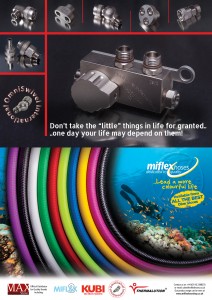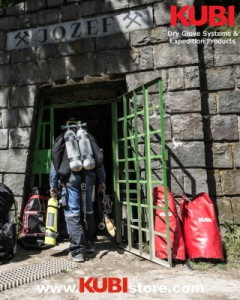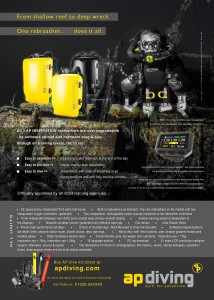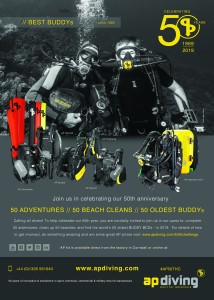DICTIONARY OF EGYPTIAN SHIPWRECKS L
DICTIONARY OF EGYPTIAN SHIPWRECKS- L
FURTHER DETAILS CAN BE DOWNLOADED FROM
www.KUBIstore.com & www.Miflexhoseshop.co.uk
S.S. LADY FRANCES
Built in 1876 by W Gray and Co at Middlesborough, for Jackson Bros & Cory, she was 246 ft long, 1375 tons and fitted with compound inverted steam engines. Her final voyage to Alexandria with a cargo of coal from the Tyne ended 150miles west on the Ishailah rocks on the 11th September 1885. The crew put to the boats, 8 got ashore,7 drowned and 2 men were rescued days later by a tug
M.V.LARA
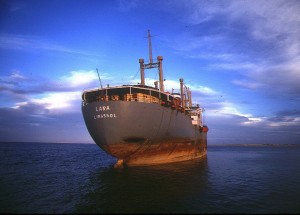 In 1983 She was driven ashore and had barely enough fuel for the journey. For many years this vessel sat on top of the reef with her stern hanging over the reef edge. She was systematically stripped and all that remains above the surface is a skeletal frame. There is however an interesting “debris field” on the coral slope. Many fittings, pipes, hatches and portholes lie scattered around and are slowly being covered by a healthy coral growth. The wreckage extends down the reef slope into the depths below, but because of the lack of interest in the wreck there are many interesting bits and pieces At 48 mtrs a mast covered in huge soft corals comes into view, pointing upwards and towards the reef at about 60 degrees. At the base is a section of superstructure, probably the lifeboat deck, galley and workshops, lying over towards the reef in 55 mtrs. The interior had been completely stripped, even dividing walls had been removed, and making exploratory swim through’s easy. Again this section is well encrusted with soft corals although there are few reef fishes at this depth.
In 1983 She was driven ashore and had barely enough fuel for the journey. For many years this vessel sat on top of the reef with her stern hanging over the reef edge. She was systematically stripped and all that remains above the surface is a skeletal frame. There is however an interesting “debris field” on the coral slope. Many fittings, pipes, hatches and portholes lie scattered around and are slowly being covered by a healthy coral growth. The wreckage extends down the reef slope into the depths below, but because of the lack of interest in the wreck there are many interesting bits and pieces At 48 mtrs a mast covered in huge soft corals comes into view, pointing upwards and towards the reef at about 60 degrees. At the base is a section of superstructure, probably the lifeboat deck, galley and workshops, lying over towards the reef in 55 mtrs. The interior had been completely stripped, even dividing walls had been removed, and making exploratory swim through’s easy. Again this section is well encrusted with soft corals although there are few reef fishes at this depth.
DIVING THE WRECK
Swimming out of this section a strange pointed structure appeared below; the solid structure is sectioned with oval cut outs and a row of studs running along its edges. At first it looks like a pointed vertical structure tapered at one end, which had fallen over. Swimming over the side the huge prop with 7ft flukes, a rudder hard over to starboard and the rudder post standing 2 mtrs high can be seen . This is the keel section of the LARA. The upper hull of this 40 mtr section was removed while the ship was still above water. Even so the prop and rudder made an impressive sight. In one of the topside shots the stern can be seen starting to break off.
The superstructure had obviously been dumped after the stern section and had landed onto of the upright keel! I had not seen this part of the LARA since 1983 two days before the sinking of the Giannis D . It is a strange dive; the confused state of the wreckage plus a touch of the narks has kept us all guessing, never the less it is a very interesting and colourful dive, the corals are huge and profuse and the silence is deafening! with the added bonus of the debris field and surrounding reef to off gas on and all in all you have a great tech / extended range dive. It should also be notes that Hammerheads are often seen in the deep water around the wreck. If gas allows, it’s a nice swim back to the south side where most boats moor, getting round the corner can be a bit tricky,it’s a case of reading the reef and watching the antheas laying in the current
M.V LAURA SECURITY
At first glance the wreckage of the Laura security looks disappointing due to its lack of depth .However below the waves is a photographic studio-back ground props and shoaling fish bathed in strong sunlight await the underwater photographer.
This small 57 mtr long coastal motor tanker was built at Karlstad in 1956, 441 ton gross was fitted with an Alpha diesel 5 cylinder oil engine built at Fredrikshaven. She had sailed under various other names; BALTICA , BALTIC (69), NIKI (81) until she became the LAURA SECURITY in 1981 when she was purchased by Malacontas S.A. registered in Pamama.
She ran aground with a cargo of gas oil in heavy weather on a voyage from Suez to Ras Shukier on April 22nd 1983 and was deemed a total constructive loss.
The vessel sits upright with its bridge out of the water. Many of the hull plates had fallen to the seabed allowing sunlight to stream through its vertical supports highlighting shoals of fish. The strong sunlight afforded by the shallow depths provided endless photo opportunities.
With the hull intact the bow and stern are very photogenic and the supporting fish life is quite amazing. It is possible to explore the fo’c’sle and engine room-the later being the deepest part of the wreck in only 8mtrs Due to its location the wreck is blessed by the afternoon sun and the long beams of light shine through many holes in the wreck. Those who are not put off by the lack of depth are well rewarded The deck lies in only 6 mtrs, but all of her valves, piping and other fittings are all still in situ. Shoals of fish find shelter amongst the frameworks
L’ARTEMISE
The L’Artemise was a 32-gun, 600 ton Magicienne class frigate of the French Navy. She was laid down at Toulon in December of 1791 as the Aurore when the British had captured Toulon. She was finished when the city was retaken on 24 July 1794 and subsequently renamed L’Artemise. Placed in service in November 1794.
The ship was 44.2 meters in length, 11.2 meters in beam, and 5.2 meters in draught. Armament consisted of 26 x 12 pounder long guns and 6 x 6-pounder long guns.
Painting of L’Artemise by Julian Stockwin
The L’Artemise took part in a naval action on 23 June 1795 with the 40-gun Minerve against the HMS Dido and the HMS Lowestoffe. The Minerve was captured during this action while the L’Artemise was able to escape. Her captain was later relieved of his command for leaving the Minerve.
In 1798, the L’Artemise was part of Napoleon’s Expedition of Egypt and participated in the Battle of the Nile. During the battle she was engaged by the HMS Orion and HMS Theseus. (see L’Orient for an account of the Battle of the Nile.)
Below is an excerpt from “American Independance and the French Revolution” (S. E. Winbolt, M.A., and Kenneth Bell, M.A.):
LE PATRIOTE
The Le Patriote was one of the 400 ships which Napolean Bonaparte used to transport over 50,000 men from France to invade Egypt in 1798. In addition to military troops, Napoleon brought with him 151 savants (artists, scientists, engineers, scholars, etc.) to document the culture of Egypt. The Le Patriote has been described as one of the research vessels, probably a commandeered merchant ship, which brought these savants and many of their research supplies and equipment from France, having departed Toulon on 19 May, to Egypt, arriving on the shores of Alexandria on the first of July.
The arrival of the savants was not an easy one. Approaching the coast of Egypt, Le Patriote struck a reef, known today as “EL-Fara Reef”, located to the west of the harbour entrance and was fast aground. The savants and ship’s crew were able to abandon the ship and safely reach the shoreline located a few hundred meters away. However, the ship eventually sank where it had struck the reef, taking with it many of the scientific tools and research materials which the savants required.
History shows us that while Napoleon’s military invasion of Egypt was a failure, in part due to the loss of his capital warships during the Battle of the Nile and becoming stranded in Egypt, the scientific expedition was a greater success than anyone had envisioned. The scientific expedition resulted in the discovery of the Rosetta Stone which was the key to deciphering hieroglyphics, the publication of the “Description de l’Égypte” published from 1810-29, the founding of the Institut d’Éypte (which eventually became the modern day Cairo Museum), and “Scientific and Military History of the French Expedition to Egypt” in 1830-36, among other works.
The Le Patriote however, was forgotten where she sank. The man most affected by the loss of the scientific equipment and materials onboard the ship was Nicolas-Jacques Conté, a chemist and inventor, who remained in Alexandria for some months afterwards manufacturing replacement equipment for the expedition. He was also the commander of Napoleon’s “Aerostatic Corps” in charge of the expeditions survey balloons and equipment. He was known as a ingenious inventor of which Gaspard Monge, a fellow scientist and a mathematician said: “He had all of the sciences in his head and all of the arts in his hand”.
While in Alexandria Conté invented and built an engraving machine which greatly improved the quality of the engraving process and saved numerous man-hours, manufactured surgical equipment, tools and utensils, minting equipment and windmills. (Trivia Note: Conté is also known and the inventor of the pencil in 1795, which still bears his name today!)
Meanwhile, the Le Patriote remained forgotten and was lost to history until, in 1983 and 84, Jacques Dumas and the Egyptian Underwater Archaeology Department (DUA) were conducting surveys of Napoleon’s fleet in Aboukir Bay located to the east of Alexandria. In addition to identifying the wreck of L’Orient, the wrecks of 3 other ships of the fleet were discovered. In 1986, The Société Français de Recherché Archéologique Sous-marines (SOFRAS), assisted by the French Navy, conducted excavations of these ships. Information learned from the research and excavation of these ships aided in determining Le Patriote’s final resting place in 4-meters of water on the western end of EL-Fara Reef which is located to the west of the modern day beach resort area of Agami.
The wreck of the Le Patriote was excavated in the same year, with many artifacts being recovered. The artifacts were delivered to the DUA’s labratory located in the Stanley district of Alexandria for conservation, restoration, and study. This, at the time, was the largest conservation and restoration project which the DUA had conducted to date.
HMS LIVELY
Built at Cammel Laird, Birkrnhead, launched in 1941,she was an L-Class destroyer of 190 tons. She was362 ft long,36 ft beam draught 10ft.She could attain 36 knots though he twin geared steam turbines , had a range of 5500nm and a compliment of 221
Armament:
8 x QF 4-inch (101.6 mm) Mk.XVI guns, twin mount HA/LA Mk.XIX
4 × QF 2 pdr Mk.VIII L/39 (40 mm), quad mount Mk.VII
8 × QF 0.5 in Mk.III Vickers (12.7 mm), quad mounts Mk.III
8 (2×4) tubes for 21 in torpedoes Mk.I
She was allocated to join the 22nd Destroyer Flotilla in Alexandria on the 24th of February 1942 and sailed for Tobruk, arriving on the 27th.to support the beleagured garrison she left Tobruk the next day and got back to Alexandria on the 2nd of March.
On March 10th 1942 HMS Lively sailed from Alexandria as part of the escort of a cruiser force commanded by Admiral Vian in the Dido Class anti-aircraft cruiser HMS Naiad, to attack an Italian cruiser reported to be damaged, the force consisted of 3 cruisers, the flagship, HMS Dido and HMS Euryalus, (Also Dido Class ships)with and escort of 8 destroyers including HMS Lively, the others being the Javelin class HMS Kipling, HMS Kelvin, HMS Sikh, HMS Zulu, which were both Tribal class, and the H class destroyers HMS Hasty, HMS Havock and HMS Hero, the force was later joined by the Dido class anti-aircraft cruiser HMS Cleopatra and the Javelin class destroyer HMS Kingston from Malta.
The report of the damaged cruiser proved to be incorrect however and the task force turned back for Alexandria, repelling several air attacks from German bombers and Italian torpedo planes. On the 11th of March however the Flagship was hit by a torpedo from the German U boat U565 and sank North of Mersa Matruh at 32.00N 26.19E, 82 members of the crew of were lost in the attack, and 582 survivors were picked up by HMS Lively, HMS Kipling and HMS Jervis. They returned to Alexandria, arriving on the 12th
HMS Lively sailed from Alexandria in company with the destroyers Sikh, Zulu and Havock on the 14th, escorting the cruisers Euryalus and Dido. The next day this force bombarded Rhodes then returned to Alexandria on the 16th
By this stage, the pace of the war in the Mediterranean was increasing as the axis powers attempted to stop the British resupplying their forces in North Africa. The Island of Malta, from which the Royal Navy was attacking the Italian and German convoys, was coming under an increasing number of air raids, which resulted in a shortage of ammunition and aircraft fuel. A convoy, MW10, to resupply the island was organised from Alexandria, aware that an attempt to supply Malta would be attacked by both the German and Italian air forces and could also be attacked by Italian surface forces, although this threat was considered to be less than that from the air.
.She was torpedoed and sunk by U565 north of Sidi Barrani with the loss of2 officers and 75 ratings on March 11th 1942 While under the command of Lt Cmdr G.GL FARNFIELD
M.V.LOS 11
A Greek motor vessel built in1948, she was 1256 tons,72 mtrs long and on a voyage from Chalkis Greece to El Wej, Saudi Arabia with 1900 tons of cement on March 5 1978, when she sank 15 miles north east of Port Said, after an explosion in her engine room. The crew of 9 were all rescued. 31 37n 32 34e
MV LOULLIA
A
Built as the ANTONIA in 1952 the 3461 ton motor ship was built at Öresundvarvet A/B , Landskrona, Sweden for Rederi A/B Poseidon, Stockholm, she was 107.5 mtrs, x 14.3 mtrs, 8.49 mtrs, with diesel engines and a single screw for a top speed of 14.5 knots. In 1965 she became the Zschoau until 1978, when the ship was sold to the Blue Mediterranean Shipping Company Amman, Jordan. As the Lara she lasted only until September 9th 1981 when she ran aground on Gordon Reef, She has been a decaying landmark ever since, A forlorn life boat sits upright on the seabed ,60 mtrs below.
